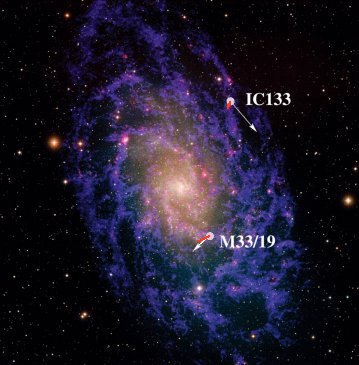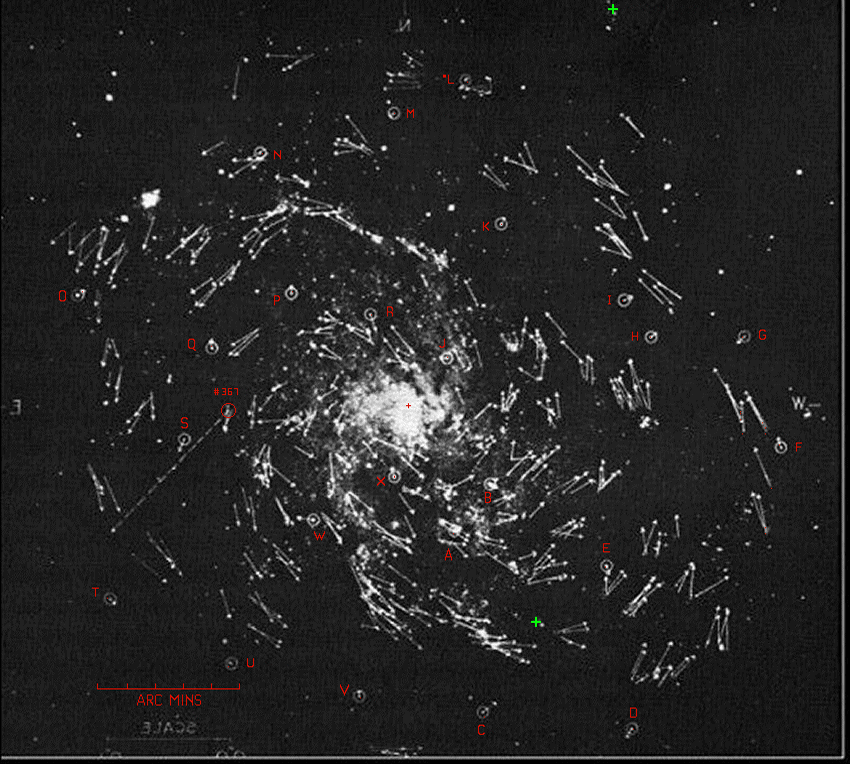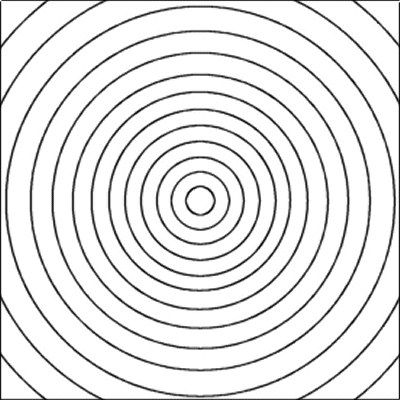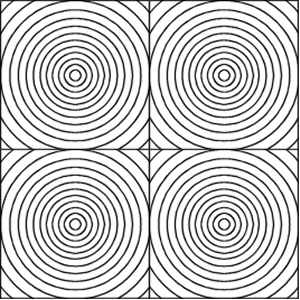|
M33 CCD Images
M33 Dark Star Image by Tony Pilato
M33 Photo Mosaic by Rob Gendler
M33 Blink Comparators by Quadrant
Northwest -
Northeast -
Southeast -
Southwest
* * *
The author of these pages is of the opinion that van Maanen's internal motions
in spiral nebulae were actually rejected by mainstream cosmology (which is
focused on the idea of the big bang with it's expanding universe, populated by
other island universes, i.e., galaxies). If van Maanen's
internal motions are real, their magnitudes would imply that the whole
observable universe is comprized solely of the Milky Way and its very
nearby environment. Spiral nebulae wouldn't be island universes, and
they would be no further from us than the Milky Way's galactic halo. For
more on this idea, see Cosmology's Missing Mass
Problems - Part 3.
- - -
Comments on Knut Lundmark's "Studies of Anagalactic Nebulae"
Lundmark(2) reported internal motions in M33. These were on the same order
of magnitude that van Maanen found, but he concluded that the motions were
of a random nature. See M33 Internal Motions According
to Lundmark.
See the
blink comparator (its not aligned right yet) which shows van Maanen's
internal motions compared to Lundmark's.
- - -
Comments on VLBI/VLBA M33 Internal Proper Motion Studies
See: Brunthaler, A., Reid, M.J., Falcke, H., Greenhill, L.J., Henkel, C.,
The Geometric Distance and Proper Motion of the Triangulum Galaxy (M33),
Science, 307, 1440-1443 (2005) (4)
Two regions of water vapor maser activity in M33 have been being studied
for internal motions since 1987(3)(4) using NRAO VLBI and VLBA facilities.
The following image shows the locations of these two areas.

M33 showing NRAO VLBI/VLBA locations for water vapor masers.
Predicted motions (white arrows) are based on a M33 rotation curve
and geometric/kinematic considerations.
VLBA measurements [inserted by author of this webpage] are shown in
red.
These two water maser regions are indicated by green crosses
on the van Maanen image at the top of this page.
The author of this page intends to "look over the shoulders" of the
researchers conducting the VLBI studies. A commentary on
their findings (and problems), compared to those of van Maanen,
follows.
VLBI/VLBA M33 Commentary
(I) - According to van Maanen, the faster moving objects in spiral nebulae tend to
travel in stream-like/spiral-arm fashion. (Spiral nebulae/galaxies may have
slow moving or even stagnant regions between the arms.)
So far, the VLBI/VLBA studies have not focused on any object that van Maanen measured.
(See image at top of this page.) In the author's opinion, until this happens,
battle will not have been joined; the "battle" being that of
a big expanding universe versus a Milky Way sized universe.
(II) - On page 39 of the 16 Aug 2004 report
[pdf] Mapping the Future of VLBI Science in the U.S., it is stated,
"...the Committee received consistent input from a significant number of
[VLBI] community members, as well as individuals serving on the Committee
itself, that the current state of VLBI-related software leaves much to be
desired." [Added 30 Oct 2005.] [Report can be reached by Googling the
underlined title. 30 May 2011]
(III) - Brunthaler et al(4) say that the water maser regions they studied
are in the eastern half of M33. The masers are actually in the western
half. Van Mannen(1) published an image of M33 as though it were being
viewed from outside the celestial sphere. His annotations on Humason's
1922 plate (shown at the top of this web page) thus have East on the
right and west on the left, but the nebula and directions are consistent.
(His image has been mirrored on this page to show a conventional
representation of the nebula.) [Added 26 Jul 2006.]
New material to be added when found.
- - -
Where van Maanen May Have Gone Wrong
Added 20 Aug 2009
On page 1441 of Brunthaler, et al(4), it is stated:
"The maser emissions in M33/19 and IC 133 are variable on time scales
less than one year. Between epochs, new maser features appeared and
others disappeared. However we were able to detect and follow the
motions of four features in M33/19 and six features in IC 133 over
all four epochs. The feature identification was based on the
positions and radial velocities of the maser emissions."
(They detected 29 distinct emission features.)
If van Maanen's nebulous objects had similar lifetimes, and his minimum
period between epochs was 12 years (radial velocities were not used
as tracking aids), he could end up identifying totally different
nebulosities as being one and the same. In 1917 Kotinsky(5) measured
internal motions in M51. His measured proper motion magnitudes were
comparable to those found by van Maanen, but the motions were in the
opposite direction. (One other astronomer at the time found similar results.)
Knut Lundmark used van Maanen's M33 starting points and found similar proper
motion magnitudes but the orientation of the majority of the velocity
vectors were inconsistent with those done by van Maanen. (see the van
Maanen - Lundmark M33 blink comparator.)
It could be that each of these observers found what they were looking for.
As far as that goes, Brunthaler, et al might have a problem as well. They
set aside more than half of their detected features because of non-conformance
with position and/or radial velocity expectations.)
Here is a graph (based on Table 1, ref(4)) showing the NRAO H2O
M33 Maser observation dates.

It would be helpful to employ a time-wise intensive VLBI/VLBA observing
regimen that would have a short enough delay between epochs such that
no newly formed maser region could be misidentified as the continued
presense of an earlier faded maser region. (Or so that features
whose proper motions are faster than what currently accepted ideas
allow don't get tossed.)
References
(1) A. van Maanen, "Investigations on Proper Motion - Tenth Paper: Internal Motion
in the Spiral Nebula Messier 33, N.G.C. 598" - Astrophysical Journal 57,
264 (1923), Plate XV.
NADS
- (van Maanen's image of M33 is an annotated print of Milton Humason's 1922
photographic plate of M33.)
(2) Knut Lundmark, "Studies of Anagalactic Nebulae - First Paper,"
Nova Acta Regiae Societatis Scientiarum Upsaliensis, Volumen
Extra Ordinem Editum, (1927).
(3) A.L. Argon, L.J. Greenhill, J.M. Moran, M.J. Reid, K.M. Menten, M. Inoue,
"The IC 133 Water Vapor Maser in the Galaxy M33: A Geometric
Distance" - Astrophysical Journal, 615, 702 (2004).
(4) A. Brunthaler, M.J. Reid, H. Falcke, L.J. Greenhill, C. Henkel, "The
Geometric Distance and Proper Motion of the Triangulum Galaxy (M33)",
Science, 307, 1440, (2005) -
NADS
-
[Link to Jive pdf no longer works. 21 Aug 2009.]
(5) Kostinsky, S., "Probable Motions in the Spiral Nebula Messier 51 (Cannes
Venatici) Found With the Stereo-comparator. Preliminary Communication,"
MNRAS, 77, 233 (1917) -
NADS
|
|




